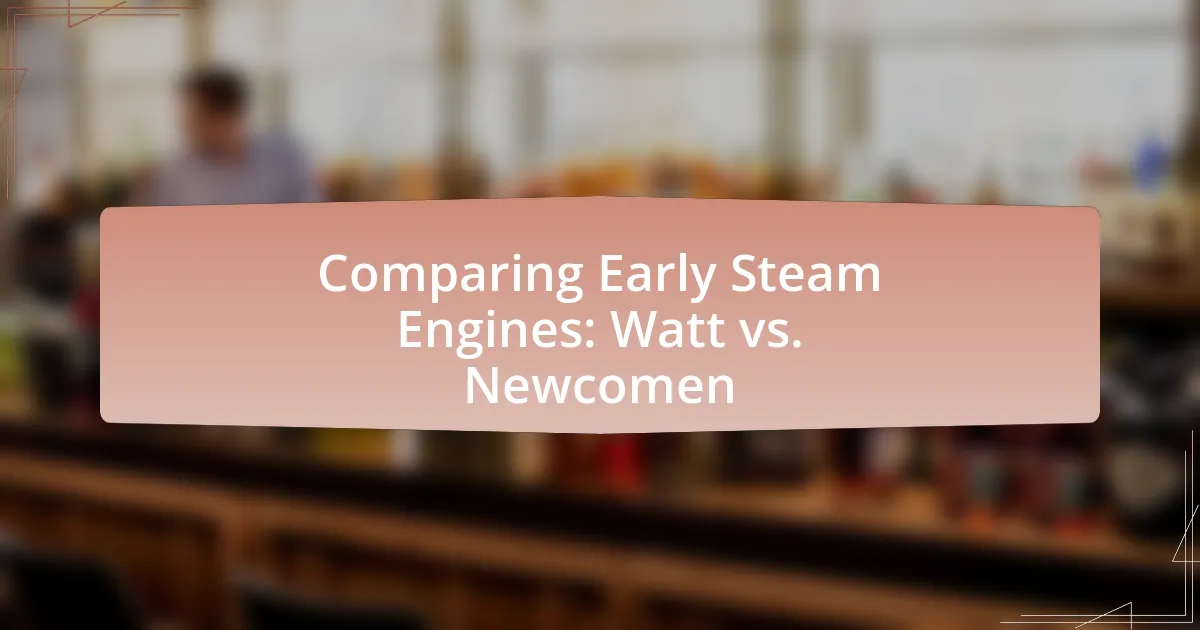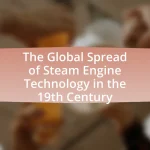The article compares the early steam engines developed by James Watt and Thomas Newcomen, highlighting their key differences in design and efficiency. Watt’s steam engine, introduced in the late 18th century, featured a separate condenser that significantly improved fuel efficiency and allowed for rotary motion, making it more versatile for industrial applications. In contrast, Newcomen’s engine, created in the early 18th century, operated at lower efficiency due to its atmospheric design and was primarily used for pumping water. The article further explores the historical context, technological advancements, and societal impacts of these engines, emphasizing their roles in the Industrial Revolution and their lasting influence on modern engineering practices.

What are the key differences between Watt and Newcomen steam engines?
The key differences between Watt and Newcomen steam engines lie in their design and efficiency. Watt’s steam engine, developed in the late 18th century, introduced a separate condenser, which significantly improved efficiency by reducing heat loss. In contrast, Newcomen’s steam engine, created in the early 18th century, utilized a simple atmospheric design that operated at lower efficiency due to the need for steam to be generated and condensed in the same cylinder. Additionally, Watt’s engine allowed for rotary motion, making it more versatile for various applications, while Newcomen’s engine primarily produced linear motion for pumping water. These innovations by Watt led to a more effective and widely adopted steam engine, marking a significant advancement in industrial technology.
How did the designs of Watt and Newcomen differ?
The designs of James Watt and Thomas Newcomen differed primarily in efficiency and mechanism. Newcomen’s steam engine utilized a simple atmospheric pressure system, where steam was introduced into a cylinder, causing a piston to move down, and then cold water was used to condense the steam, creating a vacuum for the next cycle. In contrast, Watt improved upon this design by introducing a separate condenser, which allowed steam to be condensed without cooling the cylinder, significantly increasing efficiency and reducing fuel consumption. Watt’s engine also featured a rotary motion, enabling it to drive machinery, while Newcomen’s was limited to pumping applications. These innovations made Watt’s design more practical for industrial use, leading to its widespread adoption during the Industrial Revolution.
What innovations did Watt introduce in his steam engine design?
James Watt introduced several key innovations in his steam engine design, significantly improving efficiency and functionality. He developed a separate condenser, which allowed steam to be condensed without cooling the cylinder, thus reducing energy loss and increasing efficiency by up to 75%. Additionally, Watt implemented a rotary motion mechanism, enabling the steam engine to power machinery, not just pumps, broadening its applications. He also introduced a governor to regulate engine speed, enhancing operational stability. These innovations collectively transformed steam engines into practical power sources for various industries during the Industrial Revolution.
What limitations were present in Newcomen’s steam engine?
Newcomen’s steam engine had several limitations, primarily its inefficiency and low power output. The engine operated at a low thermal efficiency, typically around 1-2%, due to the need for constant heating and cooling of the cylinder, which wasted a significant amount of energy. Additionally, it relied on atmospheric pressure to operate, limiting its ability to generate high power levels compared to later designs. The engine also required a large amount of coal to produce steam, making it economically unviable for many applications. These factors collectively hindered its effectiveness in industrial settings, particularly when compared to more advanced steam engines developed later, such as those by James Watt.
What were the operational efficiencies of Watt and Newcomen engines?
The operational efficiency of Watt engines was significantly higher than that of Newcomen engines, with Watt engines achieving efficiencies of around 20% to 30%, while Newcomen engines operated at approximately 1% to 2%. Watt’s design improvements, such as the separate condenser, reduced heat loss and improved steam utilization, leading to these enhanced efficiencies. In contrast, Newcomen engines relied on atmospheric pressure and had substantial energy losses due to the need to heat and cool the cylinder with each cycle, resulting in their low efficiency.
How did Watt’s engine improve fuel efficiency compared to Newcomen’s?
Watt’s engine improved fuel efficiency compared to Newcomen’s by incorporating a separate condenser, which allowed steam to be condensed without cooling the cylinder. This innovation reduced the amount of heat lost during the steam cycle, enabling Watt’s engine to use less fuel for the same amount of work. Specifically, Watt’s engine could operate at about 75% greater efficiency than Newcomen’s, which consumed a significant amount of coal due to its inefficient steam cycle.
What impact did the efficiency of each engine have on industrial applications?
The efficiency of each engine significantly influenced industrial applications, with Watt’s engine being more efficient than Newcomen’s. Watt’s steam engine, introduced in the late 18th century, utilized a separate condenser, which reduced energy loss and improved fuel efficiency, allowing for greater power output with less coal consumption. This advancement enabled industries to operate machinery more effectively, leading to increased productivity and the expansion of factories. In contrast, Newcomen’s engine, while innovative for its time, was less efficient due to its reliance on atmospheric pressure and significant steam loss, limiting its application primarily to pumping water from mines. The efficiency gains from Watt’s design facilitated the transition to mechanized manufacturing, ultimately driving the Industrial Revolution and transforming various sectors, including textiles and transportation.

What historical context influenced the development of Watt and Newcomen engines?
The historical context that influenced the development of Watt and Newcomen engines includes the Industrial Revolution and the need for efficient power sources in mining and manufacturing. The Newcomen engine, developed in the early 18th century, was primarily designed to pump water out of mines, addressing the challenges of flooding in coal mines. This need for improved mining efficiency laid the groundwork for James Watt’s later innovations in the late 18th century, which focused on enhancing steam engine efficiency and reducing fuel consumption. Watt’s improvements, such as the separate condenser, were driven by the growing demand for reliable power in industrial applications, reflecting the broader technological advancements and economic shifts of the Industrial Revolution.
What were the technological advancements leading to the creation of these engines?
The technological advancements leading to the creation of early steam engines, specifically those by Watt and Newcomen, included the development of the separate condenser, improved materials for construction, and advancements in thermodynamics. The separate condenser, invented by James Watt in 1765, significantly increased efficiency by allowing steam to condense without cooling the cylinder, which reduced energy loss. Additionally, the use of stronger materials, such as cast iron, enabled the construction of more durable and efficient engines. Furthermore, advancements in understanding thermodynamics, particularly the principles of heat and work, allowed for better engine designs that maximized energy conversion. These innovations collectively transformed steam engine technology, making it more practical and effective for industrial applications.
How did the Industrial Revolution shape the need for steam engines?
The Industrial Revolution significantly increased the demand for steam engines due to the rapid expansion of industries and transportation systems. As factories emerged and production processes became mechanized, the need for a reliable power source grew, leading to the adoption of steam engines for driving machinery and locomotives. Historical data indicates that by the early 19th century, steam engines were essential for powering textile mills, coal mines, and railways, facilitating unprecedented levels of production and efficiency. This shift marked a transition from manual labor to mechanized processes, underscoring the steam engine’s pivotal role in the Industrial Revolution.
What role did competition play in the evolution of steam engine technology?
Competition significantly accelerated the evolution of steam engine technology by driving innovation and improvements in efficiency and design. James Watt’s enhancements to the Newcomen engine, such as the separate condenser, emerged directly from the need to outperform existing technologies and meet the demands of industrial applications. This competitive landscape led to rapid advancements; for instance, Watt’s engine became more efficient, reducing fuel consumption and operational costs, which was crucial for industries like mining and manufacturing. The rivalry between inventors and engineers fostered a culture of continuous improvement, exemplified by Watt’s patenting of innovations that forced competitors to innovate further, ultimately leading to the widespread adoption and refinement of steam power in the Industrial Revolution.
What were the societal impacts of Watt and Newcomen’s steam engines?
Watt and Newcomen’s steam engines significantly transformed society by facilitating the Industrial Revolution, which led to urbanization and changes in labor dynamics. The introduction of these engines enabled factories to operate more efficiently, reducing reliance on water power and allowing for the establishment of industries in urban areas. This shift contributed to a mass migration of people from rural to urban settings, as job opportunities in manufacturing increased. Additionally, the steam engines improved transportation through steam-powered locomotives and ships, enhancing trade and commerce. Historical data indicates that by the early 19th century, steam power was integral to economic growth, with the textile industry, in particular, experiencing exponential expansion due to these innovations.
How did these engines affect labor and industry during their time?
The introduction of steam engines, particularly those developed by Watt and Newcomen, significantly transformed labor and industry by increasing efficiency and productivity. Watt’s engine, with its improved design, allowed for more effective use of steam power, which led to the mechanization of various industries such as textiles and mining. This mechanization reduced the reliance on manual labor, shifting the workforce from traditional agricultural roles to industrial jobs in factories.
For instance, the implementation of Watt’s steam engine in textile mills increased production rates, enabling factories to produce goods at a scale previously unattainable. This shift not only created new job opportunities in urban areas but also contributed to the rise of the Industrial Revolution, characterized by rapid industrial growth and urbanization. The demand for skilled labor to operate and maintain these engines further transformed the labor market, leading to the establishment of new training programs and educational opportunities.
Overall, the advancements in steam engine technology directly influenced labor dynamics and industrial practices, marking a pivotal change in economic structures during their time.
What long-term effects did these engines have on transportation and manufacturing?
The long-term effects of Watt and Newcomen engines on transportation and manufacturing include significant advancements in efficiency and productivity. Watt’s steam engine, with its separate condenser, improved fuel efficiency and enabled the development of more powerful engines, which facilitated the expansion of railways and steamships. This transformation in transportation reduced travel time and costs, leading to increased trade and commerce. In manufacturing, the adoption of steam power allowed factories to increase production rates and scale operations, contributing to the Industrial Revolution. Historical data shows that by the mid-19th century, steam-powered locomotives and ships had become the backbone of industrial transport, fundamentally altering economic landscapes and labor dynamics.

How do Watt and Newcomen engines compare in terms of legacy and influence?
Watt and Newcomen engines differ significantly in legacy and influence, with Watt’s engine being more impactful in advancing industrialization. Newcomen’s engine, developed in 1712, primarily served to pump water from mines, marking a crucial step in steam technology but lacking efficiency and widespread application. In contrast, Watt’s improvements in the late 18th century, including the separate condenser, enhanced efficiency and versatility, enabling steam power to drive machinery across various industries. This innovation catalyzed the Industrial Revolution, leading to increased production capabilities and economic growth. Watt’s engine laid the foundation for modern steam engines, while Newcomen’s contribution, though important, was limited in scope and application.
What contributions did Watt and Newcomen make to modern engineering?
Watt and Newcomen significantly advanced modern engineering through their innovations in steam engine technology. Newcomen developed the first practical steam engine in 1712, which utilized atmospheric pressure to create motion, primarily for pumping water from mines. This invention laid the groundwork for future steam power applications. Watt, in the late 18th century, improved upon Newcomen’s design by introducing a separate condenser, which increased efficiency and reduced fuel consumption. Watt’s enhancements allowed steam engines to be used in various industries, leading to the Industrial Revolution and transforming manufacturing processes. Together, their contributions established the foundation for modern mechanical engineering and energy production.
How are their innovations reflected in today’s steam technology?
The innovations of James Watt and Thomas Newcomen are reflected in today’s steam technology through enhanced efficiency and improved design. Watt’s introduction of the separate condenser significantly increased the efficiency of steam engines, allowing for more effective energy conversion, which is foundational in modern steam systems. Newcomen’s atmospheric engine laid the groundwork for steam power by demonstrating the practical application of steam for mechanical work, influencing the design of subsequent engines. These advancements are evident in contemporary steam turbines and industrial boilers, which utilize principles established by both inventors, such as the use of high-pressure steam and efficient heat exchange systems.
What lessons can be learned from their approaches to engineering challenges?
The primary lesson learned from the approaches of Watt and Newcomen to engineering challenges is the importance of innovation and efficiency in design. Watt improved upon Newcomen’s steam engine by introducing a separate condenser, which significantly increased efficiency and reduced fuel consumption. This innovation demonstrates that addressing specific limitations in existing technology can lead to substantial advancements. Furthermore, Watt’s focus on practical applications and user needs highlights the value of aligning engineering solutions with real-world requirements, ultimately leading to broader adoption and impact.
What practical considerations should be taken into account when studying early steam engines?
When studying early steam engines, practical considerations include understanding the technological advancements, efficiency differences, and operational contexts of the engines. The Newcomen engine, developed in the early 18th century, primarily served for pumping water from mines but was inefficient, converting only about 0.5% of the fuel’s energy into work. In contrast, James Watt’s improvements in the late 18th century introduced a separate condenser, significantly enhancing efficiency to around 3-4%. Additionally, the materials used in construction, such as cast iron and the design of the boilers, are crucial for safety and performance. Historical context, including the industrial applications and economic impacts of these engines, also plays a vital role in understanding their significance in the evolution of technology.
How can understanding these engines inform current engineering practices?
Understanding early steam engines, specifically the designs of Watt and Newcomen, can significantly inform current engineering practices by highlighting the importance of efficiency and innovation in mechanical design. The Newcomen engine, while groundbreaking, operated at low efficiency due to its reliance on atmospheric pressure, which limited its practical applications. In contrast, Watt’s improvements, such as the separate condenser, increased efficiency and reduced fuel consumption, demonstrating the value of optimizing energy use in engineering. This historical context emphasizes the necessity for modern engineers to prioritize efficiency and sustainability in their designs, as evidenced by the ongoing shift towards energy-efficient technologies in various engineering fields.
What resources are available for further exploration of Watt and Newcomen engines?
Books, academic journals, and online databases are valuable resources for further exploration of Watt and Newcomen engines. Notable books include “The Steam Engine: A Treatise on Steam Engines and Boilers” by William A. Smith, which provides detailed insights into the mechanics and historical context of these engines. Academic journals such as the “Journal of Engineering History” often publish articles analyzing the technological advancements of Watt and Newcomen. Additionally, online databases like JSTOR and Google Scholar offer access to a wide range of scholarly articles and papers that discuss the innovations and impacts of these early steam engines.


